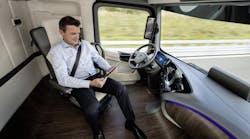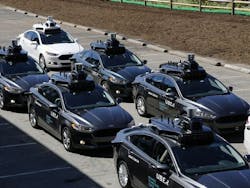There are a lot of descriptives and terms in the mix when the talk turns to autonomous vehicles (AVs) – which are also known as self-driving vehicles, driverless vehicles, robot cars, etc.
To bring some “standardization” to how we discuss the systems involved with self-driving vehicle operation, the Consumer Technology Association (CTA) recently rolled out what it calls a “common lexicon” to explain the concepts and definitions involved..
CTA’s recently-formed “Self-Driving Vehicles Working Group,” which is comprised of 34 different companies and chaired by Daimler North America Corp. and Google’s self-driving vehicle division, Waymo, spearheaded this “terminology” effort.
“A common lexicon will increase understanding amongst policymakers, consumers and other stakeholders and encourage sound policies to bring automated driving technology to market,” noted Jessica Nigro, Daimler’s manager of outreach and innovation policy and chair of this “working group.”
So what are some of these now “standardizes” concepts and terms? Here’s an initial list:
- Advanced Driver Assistance Systems (ADAS) or “Driver-Assist” Features: Onboard systems developed to improve safety and performance – examples include lane departure warnings, collision avoidance, adaptive cruise control and automatic emergency braking (AEB).
- Aftermarket Technology: Technology services or upgrades provided by companies – unaffiliated with the vehicle manufacturer – added after a vehicle is sold or leased.
- Driving Environment Sensing: The capturing, processing and analysis of sensor data (e.g., cameras and light detection and ranging radar or LIDAR) to enhance or replace what a human driver senses.
- MaaS (Mobility as a Service): The shift from personal ownership of transportation modes to shared transportation systems and services.
- Platooning: Synchronous operation of multiple vehicles, often in a convoy, to increase road capacity and efficiency.
- Self-Driving Vehicle: A vehicle capable of fully modeling its environment through an array of sensors, maps and other data in order to navigate and drive without human interaction.
- Urban Mobility: The ability for people in urban and suburban areas to access all modes and forms of transportation.
According to CTA research conducted last year, the vast majority of U.S. consumers (three out of four) are “excited about the many benefits self-driving vehicles can offer” while almost two-thirds want to swap their current cars for completely self-driving vehicles.
Additionally, 70% of consumers have a strong interest in testing a driverless car, CTA found, while almost all drivers (93%) who use existing driver-assist features appreciate the usefulness of these driving technology innovations.Yet, as I’ve noted in this space before, the “desire” to turn the driving over to autonomous vehicles may not be as widespread as many think: just go here, here and here for but a few examples.
There also remain a lot of unanswered questions regarding the use of autonomous technology in trucking, particularly in terms of crash liability and operational efficiency.
And hat’s before we start dissecting the data demands of self-driving vehicles, which will be pretty steep.
There’s also the concern about job losses – particularly among truck drivers – due to AVs.
That’s why CTA is holding an inaugural New American Jobs Summit this week in Washington, D.C., to explore how government and the private sector can collaborate to develop a competitive workforce, create new high-wage jobs and foster economic growth in the face of rapid technological innovation, an aging population and increased global competition.
“Our future will have fewer traffic collisions and fewer deaths – and self-driving cars will create undreamed of independence for seniors and the visually impaired,” noted Gary Shapiro, CTA’s president and CEO, in a statement. “We are thrilled to gather many of the different interests in the self-driving ecosystem who are committed to saving lives as soon as possible. This will improve our world.”
Let’s hope that rosy outlook is the one that comes true.




